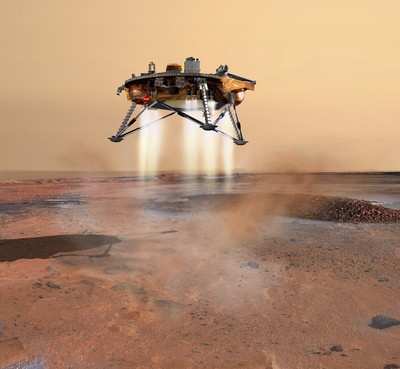Phoenix Lander On Track For May 25 Landing
NASA engineers recently adjusted the flight path of the Phoenix
Mars Lander, setting the spacecraft on course for its May 25
landing on the Red Planet.

"This is our first trajectory maneuver targeting a specific
location in the northern polar region of Mars," said Brian Portock,
chief of the Phoenix navigation team at NASA's Jet Propulsion
Laboratory in Pasadena, CA. The mission's two prior trajectory
maneuvers, made last August and October, adjusted the flight path
of Phoenix to intersect with Mars.
NASA has conditionally approved a landing site in a broad, flat
valley informally called "Green Valley." A final decision will be
made after NASA's Mars Reconnaissance Orbiter takes additional
images of the area this month.
The orbiter's High Resolution Imaging Science Experiment camera
has taken more than three dozen images of the area. Analysis of
those images prompted the Phoenix team to shift the center of the
landing target 13 kilometers (8 miles) southeastward, away from
slightly rockier patches to the northwest. Navigators used that new
center for planning today's maneuver.
The landing area is an ellipse about 62 miles by about 12 miles
(100 kilometers by 20 kilometers). Researchers have mapped more
than five million rocks in and around that ellipse, each big enough
to end the mission if hit by the spacecraft during landing. Knowing
where to avoid the rockier areas, the team has selected a
scientifically exciting target that also offers the best chances
for the spacecraft to set itself down safely onto the Martian
surface.
"Our landing area has the largest concentration of ice on Mars
outside of the polar caps. If you want to search for a habitable
zone in the arctic permafrost, then this is the place to go," said
Peter Smith, principal investigator for the mission, at the
University of Arizona, Tucson.
Phoenix will dig to an ice-rich layer expected to lie within
arm's reach of the surface. It will analyze the water and soil for
evidence about climate cycles and investigate whether the
environment there has been favorable for microbial life.
"We have never before had so much information about a Mars site
prior to landing," said Ray Arvidson of Washington University in
St. Louis. Arvidson is chairman of the Phoenix landing-site working
group and has worked on Mars landings since the first successful
Viking landers in 1976.
"The environmental risks at landing -- rocks and slopes --
represent the most significant threat to a successful mission.
There's always a chance that we'll roll snake eyes, but we have
identified an area that is very flat and relatively free of large
boulders," said JPL's David Spencer, Phoenix deputy project manager
and co-chair of the landing site working group.
Today's trajectory adjustment began by pivoting Phoenix 145
degrees to orient and then fire spacecraft thrusters for about 35
seconds, then pivoting Phoenix back to point its main antenna
toward Earth. The mission has three more planned opportunities for
maneuvers before May 25 to further refine the trajectory for a safe
landing at the desired location.
In the final seven minutes of its flight on May 25, Phoenix must
perform a challenging series of actions to safely decelerate from
nearly 21,000 kilometers per hour (13,000 mph). The spacecraft will
release a parachute and then use pulse thrusters at approximately
914 meters (3,000 feet) from the surface to slow to about 8
kilometers per hour (5 mph) and land on three legs.

"Landing on Mars is extremely challenging. In fact, not since
the 1970s have we had a successful powered landing on this
unforgiving planet. There's no guarantee of success, but we are
doing everything we can to mitigate the risks," said Doug
McCuistion, director of NASA's Mars Exploration Program at NASA
Headquarters in Washington.
 ANN's Daily Aero-Term (04.20.24): Light Gun
ANN's Daily Aero-Term (04.20.24): Light Gun Aero-News: Quote of the Day (04.20.24)
Aero-News: Quote of the Day (04.20.24) ANN's Daily Aero-Linx (04.21.24)
ANN's Daily Aero-Linx (04.21.24) Aero-News: Quote of the Day (04.21.24)
Aero-News: Quote of the Day (04.21.24) ANN's Daily Aero-Term (04.21.24): Aircraft Conflict
ANN's Daily Aero-Term (04.21.24): Aircraft Conflict




